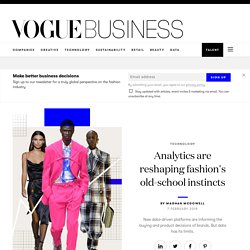

Creativity and Data: The Future of Fashion Design by Rafaella de Freitas — Fashion Roundtable. In August 2017 Amazon released a report[1] detailing how a team of programmers developed an Artificial Intelligence (AI) system that was able to generate new images of products from the input of product category (male or female tops, bottoms or shoes) and user style, determined by analysis or a number of images associated to the user such as online purchase history.

One year later, and the potential of designer algorithms remains a trending topic. The ability of an algorithm to generate designs is fascinating, but it also brings to attention questions of the value and purpose of fashion creation. Design By Algorithm; Will Robots Replace Fashion Designers? As I welcome a new group of design students to my class this week, I find myself contemplating this question as the buzz around Artificial Intelligence heats up.

StitchFix, a Silicon Valley-based subscription box service, already uses algorithms based on customer feedback to create the perfect blouse. The New Ways Retailers Are Watching You Shop. NEW YORK, United States — In Mayfair, one of London's top luxury shopping districts, customers hoping to catch a glimpse of the latest collections from Celine, Louis Vuitton and Ralph Lauren could miss a significant update to the area: The streets are watching them.

In May, Colliers, the brokerage that manages the real estate along some of Mayfair’s toniest thoroughfares, teamed up with Gyana, a human mobility tech firm. Combining Gyana GPS location data from smartphones with sensor technology installed by telecoms companies like O2, Colliers is monitoring shopping behaviour along several London high streets. Gyana uses the location tracking features embedded in countless apps on shoppers’ smartphones to follow along when they enter a store and monitor how long they spend there.
How AI is transforming the fashion industry. It may be that humans are responsible for design, but it is machines that are forecasting trends and informing product decisions.

The fact that AI is becoming an integral part of technology in the apparel industry is substantiated by the growth of its annual spending, which is predicted to nearly quadruple from 2 billion dollars in 2018 to 7.3 billion dollars by 2022, according to Juniper Research. Forecasting is but one example of using artificial intelligence in the fashion industry. New technologies are helping retailers to manage inventory using AI-powered tools to gauge demand. Chatbots are the new fashion advisors, offering a 24/7 connection to customers to help them make purchasing decisions. Savvy AI algorithms help tailor product recommendations and allow retailers to create collections customer want to buy. Edited, a retail technology company based in London that produces real-time data analytics software gives retailers access to full market data at the touch of a button.
Analytics are reshaping fashion's old-school instincts. Key takeaways: Department stores are increasingly using data to help predict the rise and decline of future trends.Fashion houses like Marni and Miu Miu use data analytics to identify opportunities and weaknesses in their collections.While data-driven tools have improved trend forecasting, human interpretation remains essential.

When Detroit-based luxury goods brand Shinola began working on its new Vinton watch, the team designed with a woman in mind, but testing the product through analytics platform MakerSights, which correlates consumer feedback with historical sales data, revealed the style appealed to all genders. As a result, the brand deepened its buy-in on those by about 70 per cent. Artificial intelligence: the opportunities and threats. Success in fashion retail was once predicated on having an instinct for the next big thing.

But in an omnichannel, social media-saturated consumer environment, human powers of divination alone – even those informed by trend forecasters – are not enough. The best fashion businesses are increasingly combining human with artificial intelligence (AI) to improve customer service, identify consumer trends, offer greater personalisation and to ensure their supply chain is as responsive as it can be. Last month, Marks & Spencer announced it was replacing switchboard staff with AI technology to increase the speed it deals with customer complaints and queries. The system recognises human speech and routes calls to relevant departments, and will be used in all 640 M&S UK stores by the end of this month, as well as its 13 UK call centres. It has the capacity to handle more than 1 million customer calls a month.
Helping hand Getting personal. How Artificial Intelligence Will Impact The Future Of Fashion. How Algorithms Are Threatening Fashion's White-Collar Jobs. NEW YORK, United States — One of the best-selling T-shirts for the Indian e-commerce site Myntra is an olive, blue and yellow colorblocked design.

It was conceived not by a human but by a computer algorithm — or rather two algorithms. The first algorithm generated random images that it tried to pass off as clothing. The second had to distinguish between those images and clothes in Myntra’s inventory. Through a long game of one-upmanship, the first algorithm got better at producing images that resembled clothing, and the second got better at determining whether they were like — but not identical to — actual products. This back and forth, an example of artificial intelligence at work, created designs whose sales are now “growing at 100 percent,” said Ananth Narayanan, the company’s chief executive.